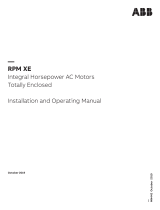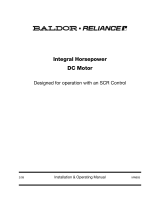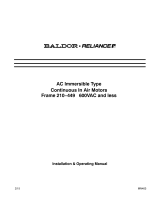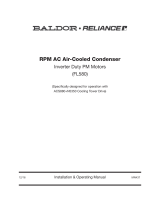
Initial Motor Inspection:
• After opening the shipping carton, check the nameplate and general construction features to confirm
the correct motor or blower was received.
• Inspect the motor for damage. If damage is detected, the motor should be placed back in the shipping
carton, and a claim filed with the carrier immediately. Do not attempt to install or use a damaged motor.
Electrical:
• CAUTION! This motor must be securely and adequately grounded by wiring with a grounded metallic
conduit or other grounding means approved by local and NEC Codes.
• Insulate all wire connections to prevent short circuits or grounding.
• Reinstall any conduit box covers. Do not force connections into the conduit box. • When connecting
any motor to the power source, connect the common lead first.
• Voltage, frequency and phase of the power supply must correspond to that shown on the motor
nameplate. Incorrect voltage or frequency may cause overheating.
Thermal Protection:
• Use thermally protected motors where required by safety regulations such as NEC in the U.S., CSA in
Canada, etc; or where a blocked shaft, overloading or other abnormal load condition may occur.
Location:
• WARNING! NBK motors marked “OSB”, those that include an “S”in the Type number, or any totally
enclosed models (those with no vent openings), are suitable in fan products that are built into a
structure or installed in unattended locations, such as bathroom exhaust fans, ceiling insert fans, attic
exhaust fans, wall insert fans, whole house fans and duct fans. NBK motors without these special
markings and with ventilation openings may present a fire hazard in equipment where an inoperable
motor would not immediately come to someone’s attention. (Ref. UL Standard 507.)
• WARNING! NBK motors without ventilation openings are not waterproof and should not be used in
damp or dirty environments. Use only UL Listed Hazardous Duty motors in hazardous locations as
described in Article 500 of the National Electrical Code.
• Use a motor with Open Vents or a Drip proof Vent pattern in clean, dry, accessible locations. • Use
Totally Enclosed Motors in damp or dirty environments or inaccessible locations.
• If the motor nameplate includes “Air-Over”,“AO”or “TEAO”, it must be mounted in the air stream of an
air-moving appliance.
Motor Control Devices:
• WARNING! Motors/blowers are not designed for use with solid-state speed controls. The use of
electronic speed controls may cause a fire or burn hazard.
• CAUTION! Supply lines must have fuses or circuit breakers to provide short circuit protection for the
motor and any motor controls.
• Any switching device used to control the motor driven appliance must have a horsepower rating equal
to or greater than the horsepower rating of the motor.
Motor Mounting:
• WARNING! Special screws are provided with motors that have screw holes in the frame. Screws other
than those provided may contact the motor coils and create a shock hazard.
• Motors or blowers must be securely mounted to an appliance to prevent objectionable noise or
vibration.
• Condenser motors typically have condensate drain plugs on both endplates. Depending on the
mounting position, the plug must be removed from the lowermost endplate.











